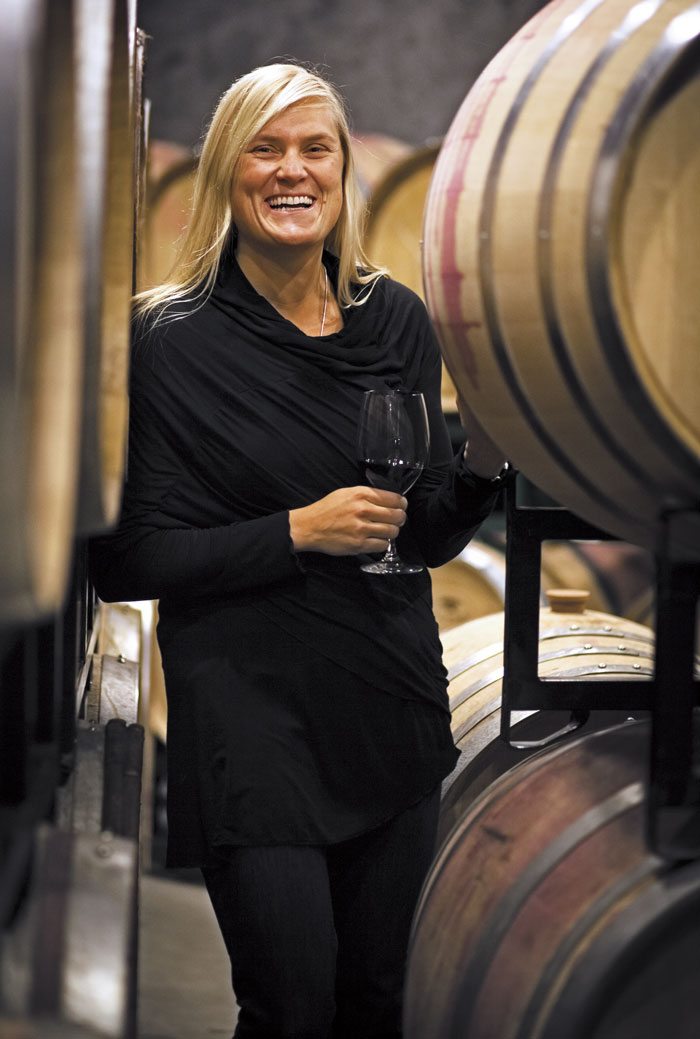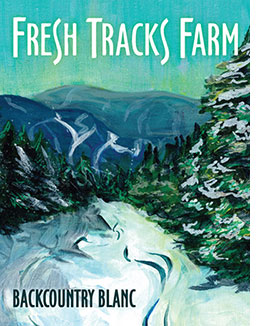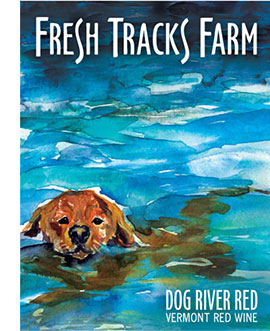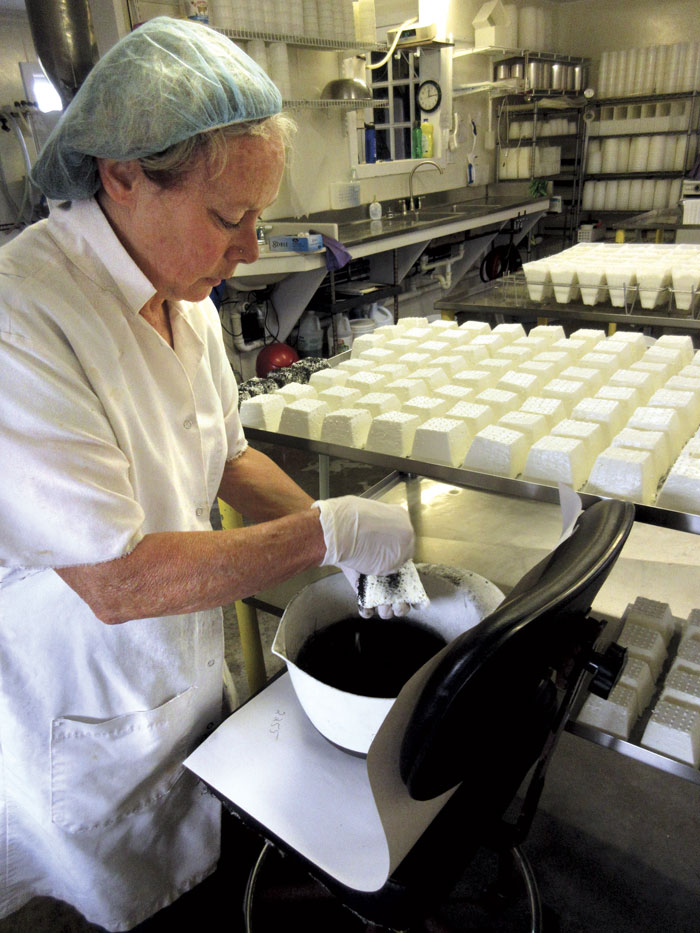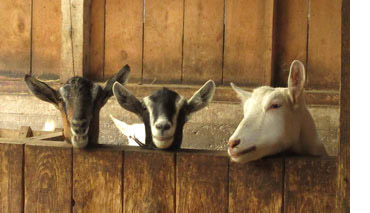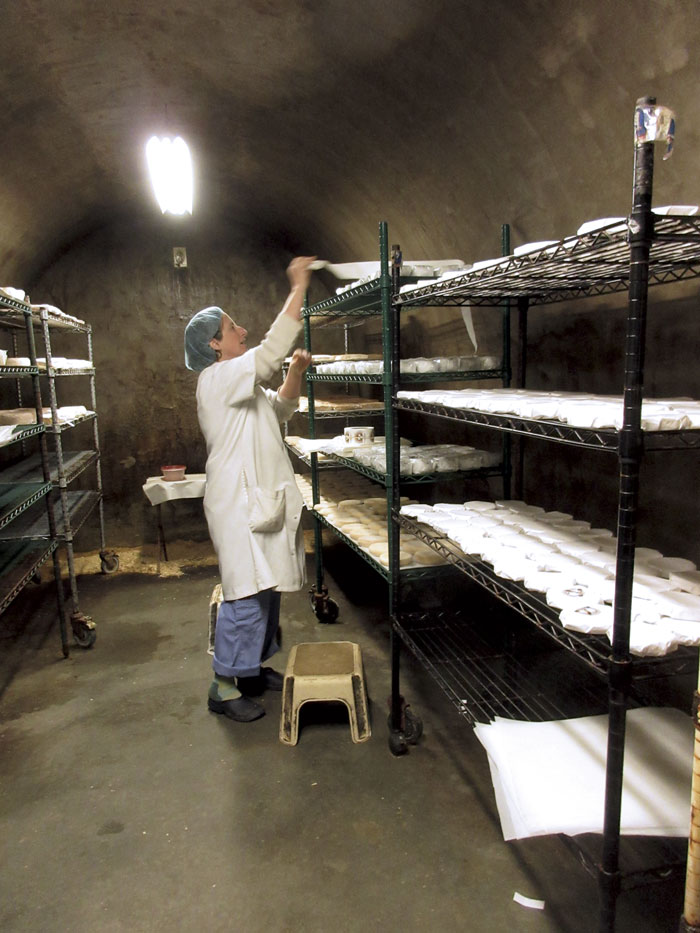| The Hardworking Women Behind Vermont’s World-Class Wine & Cheese | ||||
| by Amy Lilly | ||||
Wine, cheese, and their pairings may be more often associated with France or California than Vermont. But since the Green Mountains' artisan cheese movement took off in the 1980s, and the wine-growing movement followed suit with the introduction of cold-hardy grapes in the late 1990s, it has become possible to sample world-class examples of both products. Vermont Woman visited two women farmers who earn their livelihood creating these delectable wares: winemaker Christina Castegren, of Berlin, and cheesemaker Laini Fondiller, of Westfield. Whether Castegren's crisp, bright wines should be paired with Fondiller's rich, complex cheeses is a matter best left to the experts—including them. But both women make dependably delicious products by combining detailed attention to the science of their craft with creative sensibilities. Fiery autumn reds dot the wooded hills surrounding the 16.5 acres of vines at Fresh Tracks Farm. It's a sunny midmorning during harvest season. Six men and women work a row of vines, snipping off picture-perfect clusters of grapes with hand clippers and depositing them in crates. Elevation at this part of the farm is 1,000 feet, with no development in sight beyond the dirt farm road. Apart from a light breeze, the only sound is the distant calling of birds from their perches in the surrounding woods. |
||||
Christina Castegren vintner of Fresh Tracks Farms Winery in Berlin. photo: Jennifer Langille |
||||
| The person responsible for creating this bucolic scene is vintner Christina Castegren, 38, who founded her vineyard in 2002, a year out of college, and bottled her first vintage in 2006. Castegren is part of a select group of women winemakers that includes Patricia Farrington, the chief winemaker at Honora Winery and Vineyard in Jacksonville, on the state's southern border, and Deirdre Heekin, who founded La Garagista in Bethel. Of the Vermont Grape and Wine Council's 24 member vineyards, only Fresh Tracks and Honora are run by women. | ||||
|
||||
|
||||
"I wish I could design my own tank," she comments, tapping a taste of fermenting Marquette grapes from a tank. During harvest season, she tastes and smells each wine several times a day and tests their acidity and ph levels in beakers regularly. "This one needs a little more oxygen," she judges. Castegren knew she wanted to be a farmer as an undergraduate at the University of Vermont. "I wanted to be outside. And I really liked chemistry," she says. A plant and soil science major with a minor in small business, she interned on a vegetable farm but quickly realized that squatting on the ground all day didn't work for a six-foot-tall woman. And, at the end of the season, she recalls feeling disappointed that "everything was gone"—whereas grape vines remain. After graduating in 2001, Castegren worked her first vines at Shelburne Vineyard, one of Vermont's pioneering vineyards. At the time, wine production was relatively new in Vermont compared with upstate New York, where the industry has been developing for 15 years. (Temperatures average five degrees higher there.) Castegren jokes that she got the internship "because I had read this really long book about wine grapes, which no one ever reads."
Ken Albert, who founded Shelburne Vineyard, recalls that his vineyard was three years old and its first grapes only just maturing when he hired Castegren, his second employee. "She was wonderful," he recalls, "a fantastic, determined woman with a lot of energy and a lot of can-do attitude. Once she started working with the grape vines, she was hooked. She told me she wanted to have her own vineyard, and not in the expected place [near Lake Champlain]. And by golly she's done it." |
||||
Tasting Room, Fresh Tracks Farm |
||||
Castegren's timing was perfect. The University of Minnesota was just developing hybrid grapes, including Marquette, Frontenac, and La Crescent, that could withstand Vermont's subzero temperatures and blink-of-an-eye growing season. With the help of her family, Castegren bought 1,800 acres of farmland in Berlin and planted a few starter acres with 17 varieties. Over the years, she has pared it down to six, including her newest experiment: an acre of Itasca grapes, a variety the University of Minnesota released in 2016. She drives her Jeep up a steep dirt road to check on the scraggly little plants, which just endured their third frost. "They'll be fine," she says confidently. Castegren will spend the rest of her day tasting, testing, "punching down" rising levels of fermenting grapes in the tanks, and helping her full-time workers. (She has no seasonal employees.) The latter will pick for nine hours until darkness, and then haul their harvest to the winery. There, led by assistant winemaker Hannah Swanson, they'll sort, destem, crush, press (in the case of white-wine grapes), and ferment the grapes in various steel vats and tanks until 10 o'clock at night. Castegren will bring them lunch and dinner and cut flowers for the tasting room, amid myriad other tasks. "Sometimes I feel like a den mom running around," jokes Castegren, who is also mother to an 8-year-old boy. Does she ever enjoy the fruits of her labor—actually drinking wine in a relaxed environment? "I do like drinking," Castegren replies. "Otherwise I wouldn't want to do all this. But it's more about the agriculture and the chemistry. There's this creation of something from nothing."
|
||||
|
Far north of Berlin, in an unmarked corner of Westfield, the beautiful fall weather has finally been replaced by steady rain. That means that Laini Fondiller's 42 goats are sheltered in the barn, with four or five to each generously sized pen. There, they listen to National Public Radio all day. Fondiller has mounted a radio with exceptional reception in one corner. "My vet comes and she's like, 'I wish these goats could vote!'" says a wry Fondiller, who is working in the cheese room a few steps from the barn. "So I coined the phrase, 'One goat, one vote!'" When I arrive for the interview I find Fondiller—dressed in a blue hairnet, medical gloves, a frayed but clean white lab coat, and red rubber boots—bending over a side counter drawing lines on a 4-by-6-inch sheet of paper with a ruler and pencil. She may be making grids, but Lazy Lady is entirely off the grid: all its energy comes from a solar array on the house and a tall, spindly wind turbine. |
||||
|
||||
Fondiller could use a computer for charting—she does e-mail—but she has always kept penciled records, she explains. The lined paper will be used to record, among other details, which cheeses are made on which dates. Fondiller produces 700 rounds of cheese in multiple varieties every week. Practical and focused while she chats, the cheesemaker occasionally flashes a brilliant smile but never stops moving from task to task. She points to the sheets of butcher paper underfoot at the cheese room's entry: if a visiting reporter steps off those, she'll have to mop the immaculate concrete floor again. Fondiller grew up in Indiana and moved to Vermont in 1978. She acquired her staggering work ethic on Vermont dairy farms. "I learned stamina," she says bluntly. But the pay was paltry—no more than $25 per week—so she saved up and left for Europe. She landed in France, where she apprenticed to a cheesemaker. After three years, she was kicked out of the country for working without papers and returned to found Lazy Lady in 1987. Fondiller started with one goat and three sheep on land owned by her partner, Barry Shaw. The property had no electricity, running water, or indoor plumbing; Fondiller used a car battery to run the all-important radio and produced the cheese in her basement. "I was stone-cold broke and had no access to money," she recalls.
Unlike Castegren, she is not bucking a gender trend. The majority of the Vermont Cheese Council's 52 members are women owned and run. "It's a pretty female-dominated industry," notes Alissa Shethar, who has been making cow, goat, and sheep milk cheeses with her daughter Zarrah at Fairy Tale Farm in Bridport for the past three years. But Fondiller is among the state's earliest artisan cheesemakers and one of the most revered. Over the last three decades, Fondiller has developed more than 50 different recipes for cheeses, which she keeps in a handwritten logbook. Her cheeses have won awards from the American Cheese Society and the American Dairy Goat Association and have landed her repeated notice in national publications such as the New York Times. Her four distributors have found markets for her all over the Northeast and as far as Chicago. Even her goats have won an award: in 2015, Lazy Lady won Animal Welfare Approved certification from A Greener World, currently the most respected organization monitoring humane treatment of agricultural animals for food labeling.
But Fondiller is far from resting on her laurels. A typical day starts at 5:45 a.m. with milking the goats, putting their organic feed out, and transferring the 2,400 pounds of milk into a mixing vat. Then comes cleaning pens, whacking weeds, and "getting stuff done for haying." Fondiller does rotational grazing, moving the goats daily among 14 fenced pastures, which allows the nutritious grass two weeks to grow back in each enclosure. She makes her own hay. Three days a week she works in the cheese room until 8 o'clock at night, adding cultures or rennet, stirring or cutting cheeses, or transferring them to the curing room, where a fan blows air on them constantly. All 700 plastic forms used to shape each hunk of cheese must be washed weekly, not to mention the various mats on which they're dried and aged. In the two underground aging caves, which Shaw built—essentially concrete bunkers with barrel-vault ceilings—cheeses have to be flipped, washed, wrapped, and labeled according to schedules penciled in the daily logbook, a small spiral-bound notebook. Cheese making, Fondiller says, involves "a gazillion details."
After completing her charts for the day, Fondiller's next task is to sprinkle ash on 135 hunks of Bonaparte. She buys the burned grape-leaf powder from France and mixes it with salt, sprinkling the top and four sides of each blunted pyramidal form in turn. It will help the yeast culture develop a wrinkly, visually interesting rind, and it's completely edible, she assures. "The FDA is thinking about cracking down on the ash," Fondiller comments. "But then again the FDA approved OxyContin," she adds wryly, mentioning a recent New Yorker article she read. Fondiller says she's "too curious" to limit production to her bestsellers, which include Bonaparte, La Petite Tomme, an American Cheese Society award winner, and The Thin Red Line, which has a layer of smoked paprika. So, every Thursday, she makes a new cheese. The latest sits against the far wall in pyramidal forms. "I haven't decided on a name for that one yet," she says. Fondiller's names tend to be inspired by politics: Tomme Delay, Barick Obama, The Bernie, and, most recently, Believe Me. "You know how Trump always likes to say 'Believe me!'" she explains. That inventiveness is one of the things that sets Fondiller apart, according to Marjorie Susman, one of Vermont's pioneering artisan cheesemakers. Susman started making cow's milk cheese at Orb Weaver Farm in Monkton with her partner Marian Pollack in 1982. (The two were featured in one of Vermont Woman's earliest issues.) Susman has known Fondiller since before the latter started making cheese. "When we started [Orb Weaver], we had two kinds of cheese, and we still do. It's really one recipe; it's just aged two different ways. But Laini's been at it a long time," Susman notes, and she's still inventing new cheeses. Fondiller's main concern these days is about who will continue the operation after she retires. "All the farmers turning 65—we're all wondering who's going to take over," she says. "These days, people don't even want to put in a 10-hour day." Susman, 63, agrees. "Cheese making [sounds] so romantic, but the reality of it is, it's a whole lot of hard work," she comments. For now, though, Fondiller has no plans to curtail her workdays. "When you've been doing it this long—I still say I don't notice it," she says, turning to wash more equipment. If her replacement can be found, it will have to be an extraordinary person.
|
||||
|
Amy Lilly writes for various publications, including Vermont Woman, Seven Days, and Art New England.
|
|||
